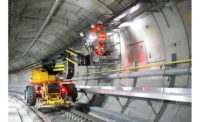At Halfway Mark, $24-Billion U.K. Crossrail Project Back on Track








The construction of tunnels and stations beneath central London as part of a $24-billion Crossrail project has hit the halfway mark on time and budget. The successes are feeding into ongoing planning for over $60 billion worth of high-speed rail.
"The industry is enjoying a renaissance and a reputation for delivering these projects on time and cost [to] a very, very high quality," says Andrew Wolstenholme, chief executive officer of Crossrail Ltd. (CRL), the city's project owner. Noting lessons learned on construction for the London Olympics in 2012, the Heathrow airport's Terminal Five project in 2008 and the London-Channel Tunnel high-speed line (HS1) in 2007, he adds, "We have a responsibility to pass that on to High Speed 2."
Like Crossrail, High Speed 2 (HS2) will entail moving mountains of materials and spoil in and out of the congested city. Crossrail experience in controlling ground settlement under numerous buildings will inform HS2, says Ailie MacAdam, CRL's delivery director and a senior vice president at Bechtel Inc., San Francisco. "We are seeing a third of the movement that was anticipated," she says. "The control on these tunnel-boring machines is extraordinary." With the right incentives, the supply chain, including design firms, "could do some really innovative stuff, if they are enabled," MacAdam adds.
An estimated 200 million annual passengers will use Crossrail when it opens in 2018, increasing by 10% the city's rail capacity, according to CRL. The 118-kilometer east-west line, between Abbey Wood and Heathrow airport, includes the tunnel section in central London, which accounts for most of the investment. Underground stations are being built in the central section at existing transportation hubs.
After the project fell behind schedule in 2012, when tunneling began, work is now at the midpoint. "We are ahead of the curve," Wolstenholme says. "Deployments of that size always take slightly longer than you think," he says.
"We've been spending over $165 million … every four weeks for the last year," adds MacAdam. Bechtel supplies around 200 of CRL's 600 staff, who manage and monitor a vast array of firms led by over 20 main contractors. MacAdam says there haven't been many major snags. She notes the unexpected discovery, in 2012, of piles, which delayed shaft construction at Liverpool Street, and the partial collapse of spoil-loading equipment at Royal Oak, also that year, which halted tunneling for three weeks.
Construction has focused on some $2.3 billion worth of 6.2-meter-dia, segmental concrete-lined twin tunnels. CRL specified and paid for the project's eight 7.1-m-dia TBMs. Germany's Herrenknecht A.G. won contracts to supply all six earth-pressure-balance (EPB) machines and two slurry TBMs—all eight costing about $16.4 million each. The EPBs were selected for the clay, sand and gravels that run through most of the route. Wet, chalky ground under the River Thames calls for the slurry machines.
The first TBM to deploy completed—in October, ahead of schedule—an 18-month drive from a portal at Royal Oak to Farringdon, says Tom Tagg, managing director of a joint venture of the U.K.'s BAM Nuttall Ltd. and Kier Construction Ltd. and Spain's Ferrovial Agroman S.A. The JV is building the western 6.2 km of the twin tunnels, including widening the running tunnels at the Tottenham Court Road and Bond Street stations and creating platforms using excavators and the sprayed concrete lining (SCL) technique. SCL is being used on a total of 12 km of platform tunnels, passages and other sections.
A joint venture (DSJV) between Dragados S.A., Madrid—which owns 90% of the JV—and Ireland's John Sisk & Sons, is excavating Crossrail's longest tunnels. It procured four TBMs for the 8.3-km-long drives from Farringdon via Stepney Green to the Limmo portal and a 2.7-km spur to Pudding Mill Lane. When the first machine on the spur reaches Stepney Green, around April, DSJV will take it by road to Limmo for the 0.9-km drive to Victoria dock. "We will be dismantling, transporting and installing a TBM in central London, which is a challenge," says Paco Gonzalez, DSJV project director.
Gonzalez says progress has been good, considering the TBMs must stop every couple of months at stations or caverns under construction. The first two TBMs have averaged seven 1.6-m-wide rings per day; a third machine achieved 10 rings per day. "We have reached one kilometer in a month," he adds.






